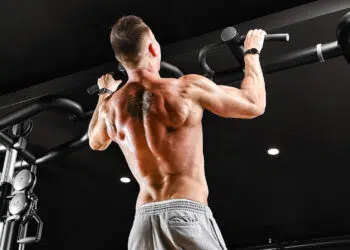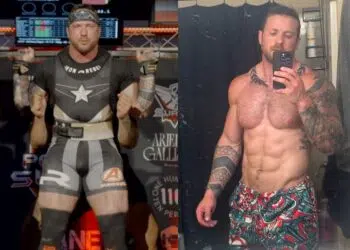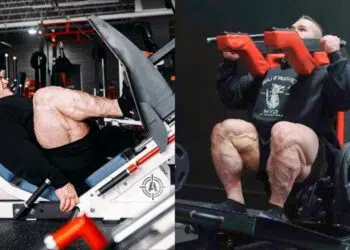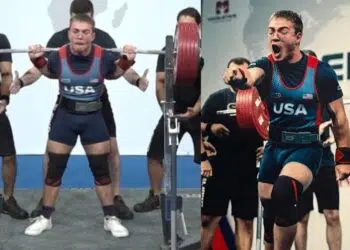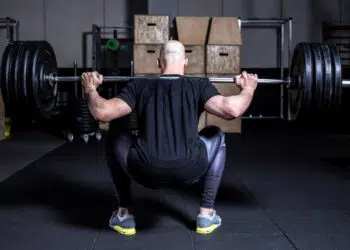If you want bigger, stronger, shapelier legs, squats should be high on your list of must-do exercises. But, while you might be able to develop decent legs without squats, if you can do the king of exercises, then you probably should.
That doesn’t mean you HAVE to do standard back squats. In fact, legendary bodybuilding trainer Vince Gironda believed that back squats increased waist and butt size and were not much good for leg development.
While the owner of the best legs in bodybuilding, Tom Platz, has long since proven that back squats CAN build an incredible lower body, it’s still worth filling your training toolbox with plenty of squat variations, so your workouts are never boring. Variety is every bit as important as intensity and training volume for triggering hypertrophy.
In this article, we take an in-depth look at close stance squats. This is a very quad-centric squat variation that is especially useful for bodybuilders.
Close Stance Squats – Muscles Worked
Narrow stance squat, like all squat variations, are a compound exercise. That means they involve several muscles and joints working together. The main muscles developed by close stance squats are:
Level Up Your Fitness: Join our 💪 strong community in Fitness Volt Newsletter. Get daily inspiration, expert-backed workouts, nutrition tips, the latest in strength sports, and the support you need to reach your goals. Subscribe for free!
Quadriceps – known as the quads for short, this is the target muscle group during close stance squats. There are four muscles in the quadriceps group: rectus femoris, vastus lateralis, vastus medialis, and vastus intermedius. All four quads extend your knees, while the rectus femoris is also a hip flexor.
Hamstrings – while close stance squats are a quad-centric exercise, the hamstrings are also involved, albeit to a lesser degree. Located on the back of your thigh, the hamstrings extend your hip and flex the knees. The deeper you squat, the more active these muscles will be. The three hamstring muscles are the biceps femoris, semimembranosus, and semitendinosus.
Gluteus maximus – the glutes work with your hamstrings to extend your hips. Located on the back of your pelvis and basically your butt, this is the largest and potentially most powerful muscle in the human body. As with the hamstrings, the further you descend, the more work the glutes will have to do. However, as close stance squats tend to involve a more upright torso and less hip flexion, the glutes, like the hamstrings, play less of a critical role in this exercise.
Abductors and adductors – located on the outside of your hips and inside of your thighs, respectively, these muscles stabilize your hips to prevent your knees from falling in or out. However, during narrow stance squats, the abductors and adductors are not as active as they are during wider-stance squats.
Core – this is the collective term for the muscles of your midsection, including the rectus abdominis, obliques, transverse abdominis, and erector spinae. These muscles work together to stabilize your lumbar spine. The more weight you use, the greater the core activation will be.
How to Do Close Stance Squats
Get more from close stance squats while keeping your risk of injury to a minimum by following these guidelines:
- Rest and hold a barbell across your upper back/traps. Make sure the bar is NOT across your neck. Stand with your feet hip-width or closer. Experiment to find the stance that works best for you. Brace your core, pull your shoulders down and back, and look straight ahead.
- Keeping your torso relatively upright, bend your knees, and squat down as far as you can without rounding your lower back or lifting your heels off the floor.
- Without bouncing at the bottom, stand back up and repeat.
- You can also do this exercise without weights, i.e., a close stance air squat.
Close Stance Squat Benefits and Drawbacks
Can’t decide if close stance squats are the right exercise for your leg workouts? Consider these benefits and then choose!
Great for quads hypertrophy – while close stance squats don’t isolate your quads, they do emphasize them. Regular stance squats involve a lot of hamstring and glutes engagement. Bringing your feet closer together means your quads become the star of this exercise. If you want bigger, more muscular quads, this exercise could help.
Squat deeper – lifters often find that they can squat deeper using a narrower stance. A close stance takes your adductors (inner thighs) out of the exercise. Tight adductors can limit squat depth. If you want to squat deeper, i.e., ass to grass, a narrower stance could be the solution.
Read more about squat depth here.
Less lower back stress – close stance squats allow you to keep your torso more upright than wide stance squats. While your spine is still under a compressive force, there is less shearing force when you keep your torso upright. If regular stance squats cause back pain, a narrower stance could provide some relief.
While close stance squats are a mostly beneficial exercise, there are also a couple of drawbacks to consider:
Increased knee joint stress – close stance squats invariably mean a larger range of motion at the knees and more forward knee travel. This puts more pressure on your knee joints than wider stance squats. While this increase in knee joint stress should not cause knee pain, it could make things worse if you have existing knee issues.
Lift less weight – when you adopt a narrow stance for squats, you put more weight on your quads, and your glutes, hamstrings, and adductors are unable to generate as much force as usual. This will reduce the amount of weight you can lift. So, while close stance squats are an effective hypertrophy exercise, they’re not as useful for developing maximal lower body strength.
10 Close Stance Squat Variations and Alternatives
Close stance squats are a highly effective quad-centric lower body exercise, but that doesn’t mean you need to do them all the time. There are plenty of variations and alternatives you can use to keep your workouts productive and interesting:
1. Cyclist Squat
Pro cyclists often have HUGE thighs. This exercise mirrors the demands of sprint cycling to overload and build your quads. You can do this exercise with a barbell on your back, holding a kettlebell or dumbbell in front of your chest, or without weights as a high-rep, pump-inducing bodyweight exercise.
Level Up Your Fitness: Join our 💪 strong community in Fitness Volt Newsletter. Get daily inspiration, expert-backed workouts, nutrition tips, the latest in strength sports, and the support you need to reach your goals. Subscribe for free!
How to do it:
- Place two bumper weight plates on the floor about hip-width apart. Alternatively, use a length of wooden plank. Stand with your heels raised and the balls of your feet on the floor.
- Keeping your torso upright, bend your knees, and squat as deeply as you can without rounding your lower back.
- Stand up, stopping just short of locking your knees to keep the tension on your muscles.
- Descend again and repeat for the required number of repetitions.
- Make this exercise even more effective by incorporating blood flow restriction (BFR) training.
2. Close Stance Smith Machine Squat
The main drawback of doing close stance freeweight squats is balancing. Squatting with your feet together, especially using a barbell, can be very unstable. Avoid this problem by doing close stance squats with a Smith machine. This eliminates the need to stabilize the weight, leaving you free to focus on pumping out the reps and overloading your thighs.
Learn how to do this classic bodybuilding exercise here.
3. Close Stance Leg Press
While the close stance squat puts less stress on your lower back than regular squats, it’s not 100% lower back-friendly. Take your lower back out of the equation almost entirely by using a leg press machine. However, you MUST avoid descending too far as that could cause lumbar spine flexion, increasing the risk of injury.
To do this exercise, simply leg press as usual but position your feet so they’re no more than hip-width apart.
4. Leg Extension
Close stance squats emphasize your quadriceps, but they don’t isolate them. If you really want to wage an all-out war on your quads, try working them alone with leg extensions. Better still, do leg extensions immediately followed by close stance squats. This intense supersetis sure to trigger hypertrophy.
Read more about leg extensions here.
5. Hack Squat Machine
The hack squat machine is a very quad-centric exercise. In fact, it was a favorite of the “Quadfather” Tom Platz, who had arguably the best legs in bodybuilding. Because the weight is guided on rods, you’re free to focus on pushing your quads to the limit. Use a narrow stance to maximize quads engagement.
Learn how to use a hack squat machine here.
6. Barbell Hack Squat
While most people are familiar with the hack squat machine, the original barbell exercise is much less common. That’s a shame because it’s actually a very effective quad-builder and a valuable alternative to close stance squats. The hack squat is named after old-school strongman and wrestler George Hackenschmidt and was the inspiration for the hack squat machine. Use a narrow stance and raise your heels to hit your quads harder.
Find out more about this old-school bodybuilding exercise here.
7. Sissy Squat
Sissy squats are an old-school leg exercise from the golden era of bodybuilding. This exercise is often challenging enough with just your body weight for resistance, especially if you use it as a finisher at the end of your regular leg workout. It can also be done using dumbbells if you’ve got mighty quads or you’re doing sissy squats as your main leg exercise.
Check out our guide to doing sissy squats here.
8. Short Step Walking Lunge
Lunges are an excellent total leg exercise, working your glutes, hamstrings, and quads pretty equally. However, done with a much shorter step, they are much more quad-dominant and a viable alternative to close stance squats. Do this exercise with a barbell or dumbbells, or just use your body weight for resistance.
How to do it:
- With or without dumbbells, stand with your feet together, arms by your sides. Brace your core.
- Take a small step forward with one leg, and then bend your knees. Keeping your torso upright, lower your rear knee down to within an inch of the floor.
- Push off your back leg and step through into another rep.
- Continue alternating legs for the required number of reps.
9. Close Stance Wall Squat
Wall squats, also known as wall sits, are an isometric leg exercise. That means your muscles generate force without producing any movement. This is a good exercise for home trainers as you don’t need any equipment to do them. And yes, that intense burning you can feel in your quads is entirely normal!
How to do it:
- Find a smooth, sturdy wall to do this exercise against. Ensure the floor is not slippery, or your feet may slide out from under you.
- Stand with your back to the wall, feet about 24 inches from the baseboard and less than hip-width apart.
- Lean your back against the wall and slide down until your thighs are roughly parallel to the floor. Your shins should be vertical. Maintain good posture throughout.
- Without resting your hands on your thighs, use your legs to push your back against the wall. Do not hold your breath, as doing so will cause your blood pressure to rise.
- Push as hard as you can for a short time (10-20 seconds), or simply try and stay in position for as long as you can.
- On completion, either slide down the wall and sit on the floor to rest or use your hands on the wall to help you stand up.
10. Narrow Stance Paused Squat
Make your narrow stance squat workout even more challenging by adding a mid-rep pause. This increases time under tension, making each rep and set last longer. This is a good option if you only have limited weights available but still want a demanding leg workout.
Using a barbell, kettlebell, or just your bodyweight, do close stance squats as usual but with a purposeful pause at the bottom of each rep. The longer you pause, the tougher things get, but 2-3 seconds is a good place to start. However, to protect your knees, do not relax between reps or try to bounce back up.
Read more:
- Wide Stance Squats Guide
- How to Increase Squat Performance
- 12 Best Squat Variations for Hypertrophy
- The Smolov Squat Program
- The Old School 20-Rep Squat Routine
Close Stance Squats – Wrapping Up
Regular stance squats are a tremendous total leg exercise. They work your glutes, hamstrings, and quadriceps pretty equally. However, some lifters feel squats more in their posterior chain, leaving them with underdeveloped quads.
Close stance squats flip the script so that your quads do more of the work. This could be just what you need to ignite quadriceps hypertrophy.
If you want to build bigger, stronger quadriceps, close stance squats and the ten variations and alternatives in this article will undoubtedly help!
Interested in measuring your progress? Check out our strength standards for Smith Machine Squat, Hack Squat, Sissy Squat, and more.



